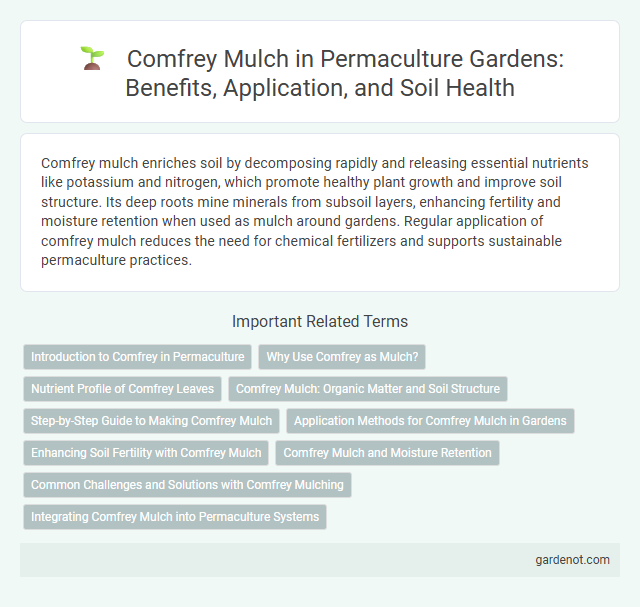Comfrey mulch enriches soil by decomposing rapidly and releasing essential nutrients like potassium and nitrogen, which promote healthy plant growth and improve soil structure. Its deep roots mine minerals from subsoil layers, enhancing fertility and moisture retention when used as mulch around gardens. Regular application of comfrey mulch reduces the need for chemical fertilizers and supports sustainable permaculture practices.
Introduction to Comfrey in Permaculture
Comfrey is a fast-growing perennial herb valued in permaculture for its deep roots that mine nutrients and accumulate potassium, calcium, and nitrogen. Its large leaves, when used as mulch, decompose rapidly to enrich soil fertility and retain moisture. Comfrey's ability to improve soil structure and support plant health makes it a cornerstone species in sustainable garden ecosystems.
Why Use Comfrey as Mulch?
Comfrey mulch enriches soil with essential nutrients like nitrogen, potassium, and phosphorus, promoting vigorous plant growth and improved crop yields. Its deep roots mine minerals from subsoil, bringing them to the surface for shallow-rooted plants to absorb. Using comfrey as mulch also conserves moisture, suppresses weeds, and accelerates organic matter decomposition, enhancing soil fertility in permaculture systems.
Nutrient Profile of Comfrey Leaves
Comfrey leaves are rich in essential nutrients, containing high levels of nitrogen, potassium, and phosphorus, which are crucial for plant growth and soil fertility. The leaves also provide calcium, magnesium, and trace minerals that support healthy microbial activity in the soil. Using comfrey mulch accelerates nutrient cycling, making it an excellent organic fertilizer in permaculture systems.
Comfrey Mulch: Organic Matter and Soil Structure
Comfrey mulch enriches soil structure by providing a dense layer of organic matter that promotes moisture retention and enhances microbial activity. Its deep-rooted nature breaks up compacted soil, improving aeration and nutrient cycling. The high nutrient content in comfrey leaves accelerates decomposition, releasing vital minerals like potassium and calcium that support plant growth.
Step-by-Step Guide to Making Comfrey Mulch
Harvest comfrey leaves at their peak by cutting just above the base of the plant, ensuring vigorous regrowth and maximum nutrient content. Chop the leaves into smaller pieces to speed up decomposition, then spread them evenly around garden beds as a nutrient-rich mulch layer. Maintain moisture in the mulch and replenish every few weeks to promote soil health and support robust plant growth.
Application Methods for Comfrey Mulch in Gardens
Comfrey mulch can be applied by cutting mature leaves and spreading them thickly around the base of plants to retain moisture and suppress weeds. Incorporating comfrey leaves directly into garden beds enriches soil with essential nutrients like potassium and nitrogen through natural decomposition. Regularly replenishing the mulch every few weeks ensures continuous nutrient release and improves soil structure over time.
Enhancing Soil Fertility with Comfrey Mulch
Comfrey mulch enriches soil fertility by providing high levels of essential nutrients such as nitrogen, potassium, and phosphorus through its deep-rooted nutrient accumulation. Its rapid decomposition releases these nutrients gradually, improving soil structure and microbial activity. Integrating comfrey mulch into permaculture systems supports sustainable plant growth and reduces dependence on synthetic fertilizers.
Comfrey Mulch and Moisture Retention
Comfrey mulch is highly effective in moisture retention due to its dense, thick leaves that create a natural barrier, reducing soil evaporation. Its deep roots draw nutrients and water from subsoil layers, which are slowly released back into the topsoil as the mulch decomposes. This process enhances soil moisture levels, promoting healthier plant growth and reducing the need for frequent watering.
Common Challenges and Solutions with Comfrey Mulching
Comfrey mulch can present challenges such as rapid growth that may overwhelm garden spaces and allelopathic effects inhibiting nearby plant growth. Managing these issues requires regular pruning and selective placement away from sensitive crops to prevent competition for nutrients and space. Integrating comfrey mulch with diverse plantings and frequent harvesting promotes soil health while minimizing its aggressive spread.
Integrating Comfrey Mulch into Permaculture Systems
Comfrey mulch enhances soil fertility by releasing essential nutrients such as nitrogen, potassium, and calcium, promoting vigorous plant growth in permaculture systems. Its deep taproot mines minerals from subsoil layers, concentrating them in nutrient-rich leaves that decompose rapidly when used as mulch. Integrating comfrey mulch reduces the need for synthetic fertilizers, supports water retention, and fosters a self-sustaining ecosystem within permaculture gardens.
Comfrey mulch Infographic

 gardenot.com
gardenot.com